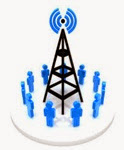Total Pageviews
Thursday 23 October 2014
Advanced Technology....globalization
Search engine
A search engine operates in the following order:
Web search engines work by storing information about many web pages, which they retrieve from the HTML markup of the pages. These pages are retrieved by a Web crawler (sometimes also known as a spider) — an automated Web crawler which follows every link on the site. The site owner can exclude specific pages by using robots.txt.
The search engine then analyzes the contents of each page to determine how it should be indexed (for example, words can be extracted from the titles, page content, headings, or special fields called meta tags). Data about web pages are stored in an index database for use in later queries. A query from a user can be a single word. The index helps find information relating to the query as quickly as possible.[17] Some search engines, such as Google, store all or part of the source page (referred to as a cache) as well as information about the web pages, whereas others, such as AltaVista, store every word of every page they find.[citation needed] This cached page always holds the actual search text since it is the one that was actually indexed, so it can be very useful when the content of the current page has been updated and the search terms are no longer in it.[17] This problem might be considered a mild form of linkrot, and Google's handling of it increases usability by satisfying user expectations that the search terms will be on the returned webpage. This satisfies the principle of least astonishment, since the user normally expects that the search terms will be on the returned pages. Increased search relevance makes these cached pages very useful as they may contain data that may no longer be available elsewhere.[citation needed]
When a user enters a query into a search engine (typically by using keywords), the engine examines its index and provides a listing of best-matching web pages according to its criteria, usually with a short summary containing the document's title and sometimes parts of the text. The index is built from the information stored with the data and the method by which the information is indexed.[17] From 2007 the Google.com search engine has allowed one to search by date by clicking "Show search tools" in the leftmost column of the initial search results page, and then selecting the desired date range.[citation needed] Most search engines support the use of the boolean operators AND, OR and NOT to further specify thesearch query. Boolean operators are for literal searches that allow the user to refine and extend the terms of the search. The engine looks for the words or phrases exactly as entered. Some search engines provide an advanced feature called proximity search, which allows users to define the distance between keywords.[17] There is also concept-based searching where the research involves using statistical analysis on pages containing the words or phrases you search for. As well, natural language queries allow the user to type a question in the same form one would ask it to a human. A site like this would be ask.com.[citation needed]
The usefulness of a search engine depends on the relevance of the result set it gives back. While there may be millions of web pages that include a particular word or phrase, some pages may be more relevant, popular, or authoritative than others. Most search engines employ methods to rank the results to provide the "best" results first. How a search engine decides which pages are the best matches, and what order the results should be shown in, varies widely from one engine to another.[17] The methods also change over time as Internet usage changes and new techniques evolve. There are two main types of search engine that have evolved: one is a system of predefined and hierarchically ordered keywords that humans have programmed extensively. The other is a system that generates an "inverted index" by analyzing texts it locates. This first form relies much more heavily on the computer itself to do the bulk of the work.
Most Web search engines are commercial ventures supported by advertising revenue and thus some of them allow advertisers to have their listings ranked higher in search results for a fee. Search engines that do not accept money for their search results make money by running search related ads alongside the regular search engine results. The search engines make money every time someone clicks on one of these ads.
Searching is done when type the text...the text is breaker into small pieces.....
Google pattern matching
Image Comparison Engines
“CBIR” is the handy acronym for Content based image retrieval. Basically, it means instead of entering text to find images, you provide or click on an existing image to find related ones. This ought to be much more intuitive for certain tasks.A CBIR research project of Penn State University has now been applied to an aviation images database,Slashdot reports. Click
on “Show me photos”, and then click on “View similar photos” to get an idea of how well this works. This is not necessary related to actual image recognition (analyzing a picture to find out it contains, say, an elephant), but can be implemented using much more brute force pixel-by-pixel image comparison with some added mirror and scaling fuzzyness.
If Google or Yahoo would add this feature to their image search, they’d have an immediate killer advantage to other image searches – and lawyers hunting down copyright infringements would have a new powerful tool at their hands.

Or... did Google already have this in place? One reader by the nick of Chefmonkey at Slashdot comments:
“Google actually did take this technology and try it. The first version of their image search had a “find similar” link next to every image. These tended to work okay at first (they weren’t great, but you usually got enough photos back that you could visually scan them and find something of interest that was related to the original image). After a few months, for some reason, the “find similar” links started returning increasingly nonsensical results. After it degenerated to the point of near uselessness, they took the “find similar” link away from the image search results. I expected it to turn up again once they got the kinks worked out, but apparently they just decided to stop working on it.”
Google returns the results....
| If you search for … | Google won't find … |
|---|---|
| cheap | inexpensive |
| tv | television |
| effects | influences |
| children | kids |
| car | automobile |
| Calif OR CA | California |
Note: There are exceptions when Google finds pages that include synonyms of your search terms, which are displayed in a boldface typeface in Google's snippet.
| If you search for … | Google finds … |
|---|---|
| NYC | New York City |
| SF | San Francisco |
| GNP | Gross National Product |
3. Similar Words Match
Google returns pages that match variants of your search terms.
The query [ child bicycle helmet ] finds pages that contain words that are similar to some or all of your search terms, e.g., “child,” “children,” or “children's,” “bicycle,” “bicycles,” “bicycle's,” “bicycling,” or “bicyclists,” and “helmet” or “helmets.” Google calls this feature word variations or automatic stemming. Stemming is a technique to search on the stem or root of a word that can have multiple endings.
If you only want to search for pages that contain some term(s) exactly, surround each such word or phrase with quotation marks (" "). See Quoted Phrases and Quotation Marks Replace the + Operator.
Google doesn't match variants when your query consists of a single term.
Note: When you want synonyms or variants that Google doesn't find, consider using either the ORor tilde operator.
4. Stop Words
Some common words, called “stop words” (such as the, on, where, how, de, la, as well as certain single digits and single letters) generally don't add meaning to a search.
Wednesday 22 October 2014
Broadcasting
Tuesday 21 October 2014
SWITCHES IN NETWORKING
SWITCHES IN NETWORKS:
What do u mean by a switch ?
switch:- a switch is a networking device used to connect the pc's ,connect to other switches in given 24 ports.
 |
| SWITCH OF 24 PORT |
If you buy a brand new switch and if you want setup an network in your office you just need to configure switch using console cable.Then after establish network as its is a switch to know the mac address of each pc it send packets using broadcasting then after next it will unicast(i.e.,single direction flow of data).
 |
| CLIENT-SERVER CONNECTION |
There two ways that server sends data to the media client1)Unicast2)MultiCast
Unicast:
Podcast
Podcasts can be browsed, previewed, and downloaded at the iTunes Store Podcast Directory.A podcast is a digital medium consisting of an episodic series of audio, video, radio, PDF, or ePub files subscribed to and downloaded through web syndication or streamed online to a computer or mobile device. The word is a neologism and portmanteau derived from "broadcast" and "pod" from the success of the iPod, as audio podcasts are often listened to on portable media players.
Merriam Webster defines Podcast: a program (as of music or talk) made available in digital format for automatic download over the Internet.[1]
A list of all the audio or video files associated with a given series is maintained centrally on the distributor's server as a web feed, and the listener or viewer employs special client application software, known as a podcatcher, that can access this web feed, check it for updates, and download any new files in the series. This process can be automated so that new files are downloaded automatically, which may seem to the user as if the content is being broadcast or "pushed" to them. Files are stored locally on the user's computer or other device ready for offline use, giving simple and convenient access to the content.[2][3] Podcasting contrasts with webcasting (Internet streaming), which generally isn't designed for offline listening to user-selected content.
As discussed by Richard Berry, podcasting is both a converged medium bringing together audio, the web and portable media player, and a disruptive technology that has caused some in the radio business to reconsider some of the established practices and preconceptions about audiences, consumption, production and distribution.[4] This idea of disruptiveness is largely because no one person owns the technology; it is free to listen and create content, which departs from the traditional model of "gate-kept" media and production tools.It is very much a horizontal media form: producers are consumers and consumers become producers and engage in conversations with each other.Definition:
Podcast - A podcast is an audio or video program formatted to be played on the iPod and made available for free or for purchase over the Internet.
Podcasts are shows, similar to radio or TV shows, that are produced by professionals or amateurs and posted to the Internet for download and listening or viewing. Many podcasts are made available for free, though some must be purchased.
The name derives from the combination of broadcast and iPod.
Podcasts can be downloaded individually or subscribed to so that each new episode of the podcast is automatically downloaded to the subscriber's computer. You can subscribe to a podcast at the iTunes Store or websites for the podcasts. Podcast subscriptions are usually facilitated using RSS
Podcasts can be browsed, previewed, and downloaded at the iTunes Store Podcast Directory.


















































